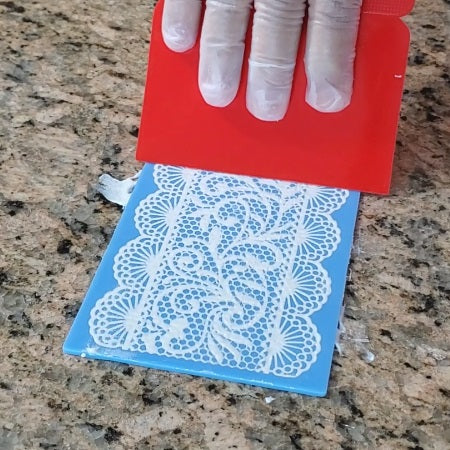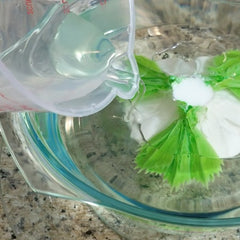
Using edible lace is a great way to elevate the look of your cakes and gelatin art desserts.
There are many methods and recipes that can be used to make edible lace. Below are several recipes for different applications. Lace made for gelatin art contains additional gelatin to help lace withstand high moisture levels of gelatin art desserts. Lace without gelatin is more suitable for regular cake decorating.
Edible lace recipes for regular cake:
Recipe 1
Recipe 2
Edible lace recipes for gelatin art:
Recipe 1
Recipe 2
When your mixture is ready, spread it over the silicone mold using a spatula or a flat piece of flexible plastic.


Use a generous amount and spread the mixture in all directions to fill all the little nooks and crannies of the mold. Press the spatula down gently to ensure the mixture is filling the mold gaps completely.
When the mold is completely covered, scoop the excess from the top of the mold.
Remove as much of the excess as you can without removing any mixture from the mold.

Excess mixture left on the mold will be visible as a tiny membrane on the finished lace. Try to scoop it all up before you leave the lace to dry.

Don't worry if you don't manage to remove it all. When the lace dries, you can use a damp napkin and wipe the dry excess from the surface.
Leave the lace to dry.
The time the lace requires to dry will depend on many factors. It may take just a few hours or a couple of days for lace to dry. You will find that different recipes, temperatures and air humidity levels will impact the the lace drying time drastically. Even different locations in your home, may have different drying times (proximity to the heater, AC or window, etc.).
We recommend to keep an eye on your lace the first time you make it. Fill the mold in the morning and check every 1-2 hours to see if the lace is firming up and coming out of the mold easily. Once you find out how long it takes for your chosen recipe to dry, in your environment, you can check the lace less often.
If you find that the lace is getting too thin as it dries, you can apply another layer of the mixture on top of the first one.
When the lace is dry, you can remove it from the mold by gently pulling it upwards or place it on a flat surface and gently remove the mold by curling it up a few inches at a time.


If you have increased the amount of glycerine used in the recipe, it is normal for the lace to be a bit rubbery. You can remove it from the mold as long as it's not getting deformed in the process. It the lace is stretching or tearing, it needs to be dried a bit longer.
Sometimes, you can't see the thin film on the back of the lace until you start to remove it from the mold. If this happens, lower the lace back into the mold and use a damp napkin to remove the dry excess.



Adding more glycerine to the recipe will make the lace soft and flexible. Below is a comparison between stiff and flexible lace:

When the lace is dry and out of the mold. Place it in an air-tight container or a plastic bag.
Finished edible lace can be used for cake decorating or inserted into gelatin art desserts.


Using edible lace in gelatin art desserts
To use edible lace in gelatin desserts, use a lace recipe that contains gelatin. Edible lace without gelatin will absorb too much moisture from the gelatin dessert and turn into a slimy liquid. It might leak out of the dessert when cut.
To place the lace into the dessert, pour little bit of warm gelatin on top of the dessert. This will help meld the dessert with a new lace layer. Do not place the lace into warm gelatin. Wait for the new layer to cool down a bit and place the lace on top of it. (If the dessert is cold, the new layer will cool down in seconds.)


Position the lace quickly. It will be hard to move it around when it starts to absorb moisture and softens.
Press the lace down to sink it into liquid gelatin and release all air bubbles that have formed.
If the lace is not completely covered with gelatin, add another layer when the first one has stiffened up.
For best results, use flat containers that are slightly larger than the lace you wish to use. Round container edges and dome containers might distort the look of lace patterns.
These two lace shapes are identical, but one looks distorted when placed too close to the dessert edge curve.

Images below show a lace by itself, a lace covered with an empty dome container and a lace covered with a dome container filled with gelatin.



Gelatin acts as a magnifying glass in dome containers and distorts the look of the underlying lace pattern.
This video shows how to make a gelatin art dessert with an edible lace background:
Frequently asked questions
What does edible lace taste like?
Edible lace is used primarily for decorative purposes and it doesn't have a noticeable flavor. You can add a small amount of food flavoring or citric acid to make it more interesting.
How long can a lace mixture last in the fridge?
Once prepared, the mixture can be kept in the fridge in an air-tight container or wrapped in plastic cling wrap. It can last a few days, but the texture might deteriorate over time.
How long does dry lace last?
If thoroughly dried and stored in air tight packaging, edible lace can last several months.
Can I dry the lace in the oven?
We don't recommend drying a lace with gelatin in the oven.
Lace without gelatin can be dried in the oven at low temperatures. You might have to experiment a bit to find the right temperature and duration that works best for your oven and chosen recipe.
Can corn starch be replaced with icing sugar?
You can use icing sugar to replace corn starch, but the lace will take longer to dry and it might melt slightly when handled by hands. Note: Icing sugar usually contains small amounts of starch powder already.
Can I use food coloring to dye edible lace?
Yes, food coloring can be used to make colorful edible lace. Most liquid and gel food colors work well in edible lace recipes.
Dark lace can look transparent when used on a light background. It is recommended to coat the mold twice to accomplish an even, solid color.
How can I make gold, silver or metallic edible lace
To create shiny edible lace, dust the lace mold with edible pearl dust using a soft makeup brush. When the mold is evenly covered, spread the lace mixture on top of it. Use lace mixture that is already colored to match the dust color (yellow for gold, gray for silver, white for pearls, etc.)
How can I make chocolate edible lace?
To make a brown, chocolate lace, replace one tablespoon of starch with one tablespoon of cocoa powder and don't use any white food coloring.
What is gum tragacanth? Can I replace it with CMC or tylose?
Gum tragacanth is substance extracted from plants. You can use synthetic versions like CMC or Tylose to replace it in recipes. Use the same amount of powder regardless of which ingredient you use.
Why is my lace brittle and crumbling?
Edible lace can be too brittle for several reasons. Most often it will break if it's over dried, if it's too thin or if you don't have enough glycerin in the mixture.
Why is mu lace tough and hard to cut on a cake?
When placed on a cake, edible lace needs to absorb moisture from the frosting to soften up and adhere to the cake. If you are placing the lace on a dry cake or you are using buttercream that has a lot of fat content and not a lot of moisture, the lace might remain dry and be hard to cut and chew.
To learn more about Gelatin Art, visit our instructions page here.
To purchase high quality gelatin or silicone molds, visit our online store.
